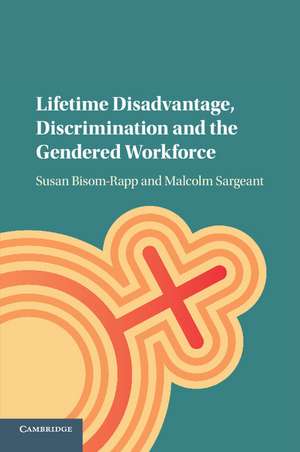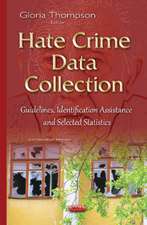Lifetime Disadvantage, Discrimination and the Gendered Workforce
Autor Susan Bisom-Rapp, Malcolm Sargeanten Limba Engleză Paperback – 13 iun 2018
| Toate formatele și edițiile | Preț | Express |
|---|---|---|
| Paperback (1) | 283.25 lei 6-8 săpt. | |
| Cambridge University Press – 13 iun 2018 | 283.25 lei 6-8 săpt. | |
| Hardback (1) | 724.45 lei 6-8 săpt. | |
| Cambridge University Press – 19 oct 2016 | 724.45 lei 6-8 săpt. |
Preț: 283.25 lei
Nou
Puncte Express: 425
Preț estimativ în valută:
54.20€ • 56.75$ • 44.96£
54.20€ • 56.75$ • 44.96£
Carte tipărită la comandă
Livrare economică 09-23 aprilie
Preluare comenzi: 021 569.72.76
Specificații
ISBN-13: 9781107558977
ISBN-10: 1107558972
Pagini: 254
Dimensiuni: 153 x 230 x 15 mm
Greutate: 0.35 kg
Editura: Cambridge University Press
Colecția Cambridge University Press
Locul publicării:New York, United States
ISBN-10: 1107558972
Pagini: 254
Dimensiuni: 153 x 230 x 15 mm
Greutate: 0.35 kg
Editura: Cambridge University Press
Colecția Cambridge University Press
Locul publicării:New York, United States
Cuprins
1. Lifetime disadvantage; 2. Education and training; 3. Stereotyping and gender discrimination; 4. Caregiving and career outcomes; 5. Glass ceilings and pay inequality; 6. Occupational segregation and non-standard working; 7. Pensions and retirement; 8. Beyond lifetime disadvantage.
Recenzii
'Drawing together this wide a range of data and to present it in such an accessible way is a fine achievement. The wealth of data offered on women's lifetime disadvantage, all of it drawn from a range of sources from the last five or six years, and demonstrating trends in discrimination and working patterns over the past 50 years, is extremely valuable to any one doing research into the impact of gender discrimination. … [a] thorough, compelling, and valuable book.' Richard Poole, Feminist Legal Studies
'Bisom-Rapp and Sargeant use a model of lifetime disadvantage to argue that antidiscrimination law adopts an incremental and disjointed approach to resolving the challenges of gender discrimination, and conclude that a more holistic orientation toward eliminating women's discrimination and disadvantage is required before true gender equality can be achieved.' Law and Social Inquiry
'The main contribution of this book is the successful combination of the sociological and the legal aspects of women's lifetime disadvantage in work. Readers who are not trained in law will likely be pleasantly surprised at the accessible and often fascinating analysis of current laws and their implementation, including the case law in the UK and the USA. The book is also a valuable source of up-to-date empirical data on gender inequality in work and retirement from both countries. The comparison between the two nations is particularly instructive as the UK is preparing to withdraw from the EU: British women benefit from various directives and the approach taken by the Court of Justice of the EU that, unlike in the USA, pregnancy-related discrimination automatically amounts to sex discrimination.' Erika Kispeter, Work, Employment and Society
'I enjoyed and admired the ambitious approach taken by Susan Bisom-Rapp and Malcolm Sargeant in their book, Lifetime Disadvantage, Discrimination and the Gendered Workforce. Their model of lifetime disadvantage was explained clearly and exhaustively researched. And I agree with their thesis, that only a holistic, comprehensive approach (rather than disjointed incrementalism), can get us closer to workplaces that are more accommodating for all workers and to a society that ends or at least ameliorates the economic insecurity for women as they age. … [I] believe it contributes to a very important discussion we need to have about how we could reimagine the workplace and society's social structures to end the oppression and contribute to the long-term economic security of all workers.' Nicole Buonocore Porte, Employee Rights and Employment Policy Journal
'Bisom-Rapp and Sargeant use a model of lifetime disadvantage to argue that antidiscrimination law adopts an incremental and disjointed approach to resolving the challenges of gender discrimination, and conclude that a more holistic orientation toward eliminating women's discrimination and disadvantage is required before true gender equality can be achieved.' Law and Social Inquiry
'The main contribution of this book is the successful combination of the sociological and the legal aspects of women's lifetime disadvantage in work. Readers who are not trained in law will likely be pleasantly surprised at the accessible and often fascinating analysis of current laws and their implementation, including the case law in the UK and the USA. The book is also a valuable source of up-to-date empirical data on gender inequality in work and retirement from both countries. The comparison between the two nations is particularly instructive as the UK is preparing to withdraw from the EU: British women benefit from various directives and the approach taken by the Court of Justice of the EU that, unlike in the USA, pregnancy-related discrimination automatically amounts to sex discrimination.' Erika Kispeter, Work, Employment and Society
'I enjoyed and admired the ambitious approach taken by Susan Bisom-Rapp and Malcolm Sargeant in their book, Lifetime Disadvantage, Discrimination and the Gendered Workforce. Their model of lifetime disadvantage was explained clearly and exhaustively researched. And I agree with their thesis, that only a holistic, comprehensive approach (rather than disjointed incrementalism), can get us closer to workplaces that are more accommodating for all workers and to a society that ends or at least ameliorates the economic insecurity for women as they age. … [I] believe it contributes to a very important discussion we need to have about how we could reimagine the workplace and society's social structures to end the oppression and contribute to the long-term economic security of all workers.' Nicole Buonocore Porte, Employee Rights and Employment Policy Journal
Notă biografică
Descriere
Critically examines discrimination and disadvantage suffered by women at work and focuses on the inadequacies of the current law.











